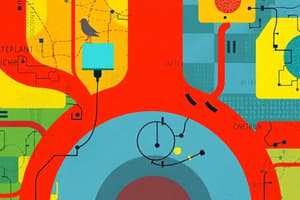Podcast
Questions and Answers
What notable invention took place around 3200 BC that marked the beginning of recorded communication?
What notable invention took place around 3200 BC that marked the beginning of recorded communication?
- The internet
- The printing press
- Writing (correct)
- The telephone
Which innovation significantly increased literacy and information dissemination in the 15th century?
Which innovation significantly increased literacy and information dissemination in the 15th century?
- The radio
- Social media
- The printing press (correct)
- Mobile apps
What is a primary characteristic of new media compared to traditional media?
What is a primary characteristic of new media compared to traditional media?
- Limited audience interaction
- Centralized control
- User-generated content (correct)
- One-directional communication
How did the emergence of the World Wide Web in the early 1990s affect communication?
How did the emergence of the World Wide Web in the early 1990s affect communication?
Which communication method is primarily replaced by instant messaging and video calls?
Which communication method is primarily replaced by instant messaging and video calls?
What characterizes traditional media compared to new media?
What characterizes traditional media compared to new media?
What was a significant societal impact of the transition from traditional media to new media?
What was a significant societal impact of the transition from traditional media to new media?
What pivotal role did advertising play during the Industrial Age of media?
What pivotal role did advertising play during the Industrial Age of media?
Flashcards are hidden until you start studying
Study Notes
Media History
-
Pre-Industrial Age:
- Communication methods included oral traditions, storytelling, and the use of physical symbols.
- Invention of writing (c. 3200 BC) marked the beginning of recorded communication.
- Development of printing press (1440) led to mass production of texts, increasing literacy and information dissemination.
-
Industrial Age:
- Birth of mass media through newspapers, magazines, and later, radio and television.
- Introduction of advertising as a significant revenue stream.
- Media became centralized, controlled by a few entities.
Digital Communication Platforms
-
Rise of the Internet:
- Emergence of the World Wide Web in the early 1990s revolutionized communication.
- Social media platforms (e.g., Facebook, Twitter, Instagram) enabled user-generated content and interactive communication.
-
Mobile Technology:
- Smartphones and mobile apps have transformed how media is consumed and shared.
- Instant messaging and video calls have replaced traditional communication methods.
-
Streaming Services:
- Shift from scheduled programming to on-demand content (e.g., Netflix, YouTube).
- Changes in advertising models and viewer habits.
Transition from Traditional to New Media
-
Characteristics of Traditional Media:
- One-directional communication (e.g., TV, radio).
- Limited audience interaction and feedback mechanisms.
-
Characteristics of New Media:
- Interactive and participatory platforms.
- Content is user-generated and often shared virally.
- Greater accessibility and convenience for users.
-
Impact on Society:
- Democratization of information; anyone can publish content.
- Challenges to traditional media's authority and credibility.
- Issues related to misinformation and the digital divide.
Media History
- Pre-Industrial Age featured oral traditions, storytelling, and symbols for communication.
- Invention of writing around 3200 BC initiated recorded forms of communication.
- The printing press, developed in 1440, facilitated mass text production, boosting literacy and accessibility of information.
- The Industrial Age saw the rise of mass media, including newspapers and radio, alongside the birth of advertising as a key revenue source.
- Media concentration led to control by a limited number of organizations.
Digital Communication Platforms
- The Internet's introduction in the early 1990s drastically changed communication dynamics.
- Social media platforms such as Facebook, Twitter, and Instagram enable users to generate and share content interactively.
- Smartphones have revolutionized media consumption and sharing, with mobile apps providing access on the go.
- Instant messaging and video calls have largely replaced traditional forms of communication.
Transition from Traditional to New Media
- Traditional media is characterized by one-way communication, with limited audience engagement (e.g., TV, radio).
- New media promotes interactivity and participation, with content often generated by users and spread virally.
- New media offers greater convenience and accessibility, significantly altering user experiences.
- Societal impacts include increased democratization of information, allowing anyone to publish content.
- Traditional media faces challenges to its authority and credibility, compounded by issues like misinformation and the digital divide.
Studying That Suits You
Use AI to generate personalized quizzes and flashcards to suit your learning preferences.




